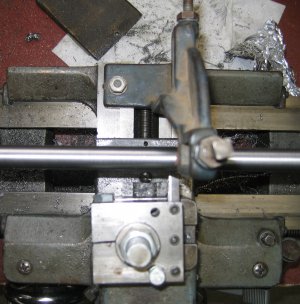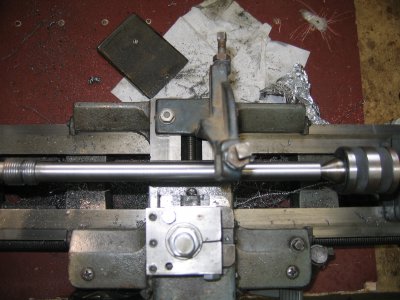- Joined
- Apr 12, 2013
- Messages
- 562
Offering this up for comment and constructive criticism...no old guys around that I know to mentor me and I have read all I can, time to give it a try! Please be gentle! LOL
I may be biting off more than I can chew but here goes. I bought a Green Mountain blank on special, only 21", Stainless Steel, 6mm, 1:9 twist, to build a handy (hoping to get a 20" working barrel but 18" would be ok) 243Win rifle on an old Rem 700 action I have been working with. I have a couple of takeoff barrels thanks to another member here and have swapped them a couple of times, so I have a good working vise and action wrench.
First step, turning to shape. I want a slightly heavy barrel, basically minimum taper forward of the chamber...somewhat because I like the look and somewhat because I don't want to mess with turning a taper. I have a 3/4" spindle bore so I want to turn the forward 3/4 of the abrrel to about that diameter, then flip to turn the chamber end. I will blend the transitions in later. I have to work between centers due to the small spindle bore. That leaves me either losing a lot of barrel to chop off the section under the dog or resetting it to turn the other end. Good or bad? Pic of setup below.

Second question, the blank was off center when I started. I took an hour thinking my pins were bad but in the end I think the blank was really a good 8-10 thou off at one end. Is that common? Pic of center pins below.

My order of operations, let me know if I am missing anything:
1) Rough turn 3/4 of barrel length including muzzle end between centers
2) Flip and rough turn chamber end and taper (steps and grind to shape later in step 4?) transition. Cut and thread receiver tenon.
3) Switch to 4-jaw, use spider on left end of spindle and 4 jaw to align, then cut face for Rem 700, rough chamber (I have Forster reamer and gauges)
4) Go back to centers, use belt grinder to finish sand to final surface (protect lathe from grit!)
5) Return to 4 jaw, final finish chamber by hand
6) Crown
7) Final install on receiver, final verify headspace, reassemble and test fire...
I may be biting off more than I can chew but here goes. I bought a Green Mountain blank on special, only 21", Stainless Steel, 6mm, 1:9 twist, to build a handy (hoping to get a 20" working barrel but 18" would be ok) 243Win rifle on an old Rem 700 action I have been working with. I have a couple of takeoff barrels thanks to another member here and have swapped them a couple of times, so I have a good working vise and action wrench.
First step, turning to shape. I want a slightly heavy barrel, basically minimum taper forward of the chamber...somewhat because I like the look and somewhat because I don't want to mess with turning a taper. I have a 3/4" spindle bore so I want to turn the forward 3/4 of the abrrel to about that diameter, then flip to turn the chamber end. I will blend the transitions in later. I have to work between centers due to the small spindle bore. That leaves me either losing a lot of barrel to chop off the section under the dog or resetting it to turn the other end. Good or bad? Pic of setup below.

Second question, the blank was off center when I started. I took an hour thinking my pins were bad but in the end I think the blank was really a good 8-10 thou off at one end. Is that common? Pic of center pins below.

My order of operations, let me know if I am missing anything:
1) Rough turn 3/4 of barrel length including muzzle end between centers
2) Flip and rough turn chamber end and taper (steps and grind to shape later in step 4?) transition. Cut and thread receiver tenon.
3) Switch to 4-jaw, use spider on left end of spindle and 4 jaw to align, then cut face for Rem 700, rough chamber (I have Forster reamer and gauges)
4) Go back to centers, use belt grinder to finish sand to final surface (protect lathe from grit!)
5) Return to 4 jaw, final finish chamber by hand
6) Crown
7) Final install on receiver, final verify headspace, reassemble and test fire...


